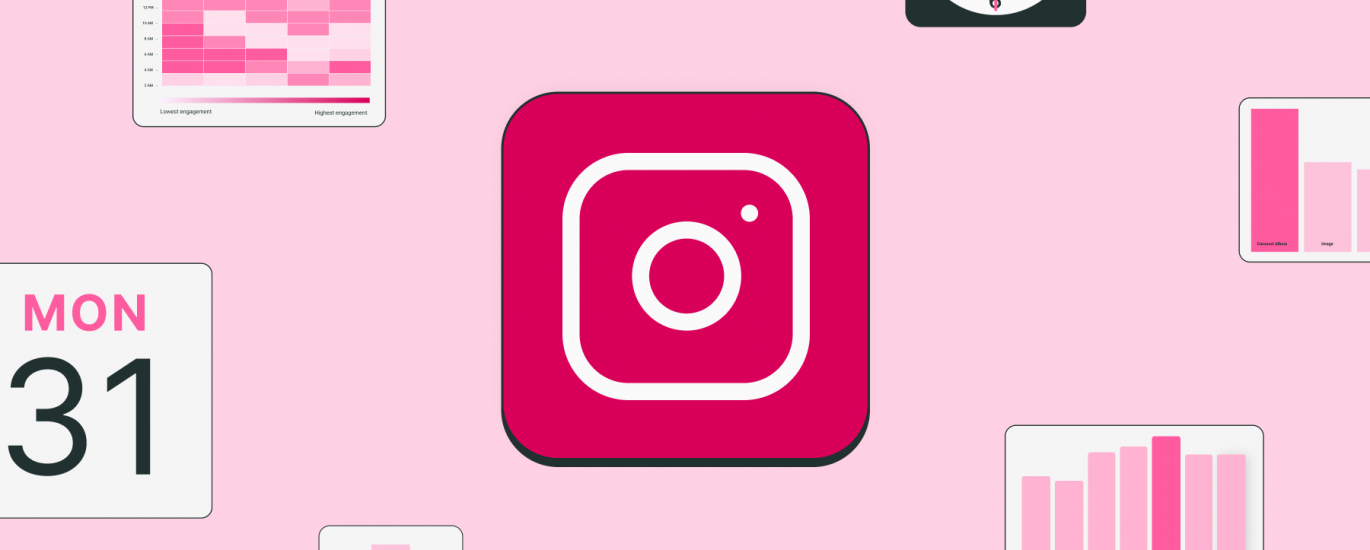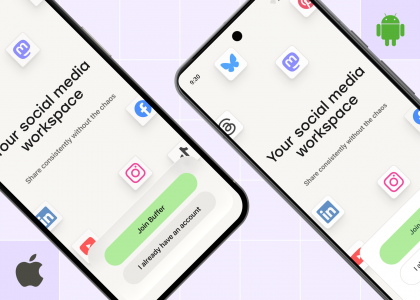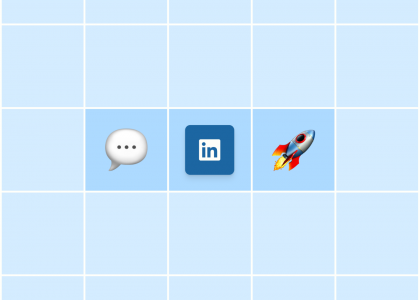When it comes to growing your Instagram following, it’s no secret that Instagram Reels can be a powerful tool. The Meta-owned platform has been doubling down on video content in recent years, with CEO Adam Mosseri candidly sharing that, “People are more interested in videos — they’re just more engaging.”
Now, that may be true — but it depends on how you define, “engaging.”
An analysis by Buffer’s data scientist-in-residence Julian Winternheimer uncovered that, since 2022, Instagram Reels have consistently outperformed carousels (multi-image posts) and single-image posts when it comes to reach.
The same can’t be said for engagement, however. Our data shows that carousels perform best pretty consistently in terms of engagement, meaning carousels are far more likely to receive likes, comments, and shares than videos, and far more likely to than single-image posts.
But what does this all mean — and how can you use this information to inform your content strategy and social media content calendar? Let’s take a closer look.
About this analysis
In this analysis, we reviewed the data from more than 4 million posts sent from Buffer from January 2022 to October 2024.
How we define reach
At Buffer, our metrics for Instagram are based on their own definitions. So we define Instagram reach as Instagram does, reach is the “total number of times the account’s media objects have been uniquely viewed.”
In layman’s terms, reach is how many times your post was viewed in other Instagram feeds.
How we define engagement
Again, we define post engagement the same way as Instagram does: the “number of likes, saves, comments, and shares on the post, minus the number of unlikes, unsaves, and deleted comments.”
In a nutshell, that is how many interactions you get on your posts, including likes, comments, and shares.
With all that explained, let’s move on to our key findings:
Instagram Reels see 36% more reach than other post types
There’s something in the idea that regularly sharing Instagram Reels is the best way to grow your Instagram following.
Our analysis shows that reels see more than double the reach of single-image posts and 1.36 times more than carousels — though those do tend to get better reach than their one-image counterparts.
Some quick takeaways are that, on average:
Instagram Reels get 1.36 times (36 percent) more, reach than carouselsInstagram Reels get 2.25 times (125 percent) more reach than single-photo posts.
Why do reels perform so much better? While there are likely scores of reasons for this, it’s likely largely down to the fact that reels have a feed all of their own.
We know that different parts of the Instagram app are governed by different algorithms, and the reels feed is no different.
The reels feed, accessed by tapping the video icon at the bottom of the app, is designed to help users find new brands and creators. That means it’s not dominated by friends, family, and creators and brands they already follow in the way that their main feed is.
Here, Instagram is more likely to recommend new content to users. Thanks to this feed, a reel is more likely to be shown to more non-followers.
All that said, we’re certainly going to be seeing some shifts here in the coming months, as Instagram has just announced that photos and carousels with added music will now be eligible to appear in the reels feed. More on this to come.
Instagram Carousels see 12% more engagement than other post types
Interestingly, the picture looks a little different for engagement on Instagram posts. While reels do still outperform single-image posts when it comes to likes, comments, and shares, our data shows that carousels come out on top.
On average:
Instagram Carousels get 1.12 times (12 percent) more engagement than Instagram ReelsInstagram Carousels get 2.14 times (114 percent) more engagement than Instagram single-image posts.
Again, there are plenty of reasons why this might be the case. Another of Adam Mosseri’s videos provides more insight:
“Posting multiple photos at once can make it a richer experience,” he says. “It also gives that feed post multiple chances to show up in follower’s feeds.”
For instance, if someone only tapped through one or two photos, the carousel might pop up in their feed again, helping them pick up where they left off.
It likely also comes down to how Instagram users behave in the various different feeds on the platform. On the reels feed, it’s more likely they’re swiping through content looking for entertainment.
On the home feed, where your carousel posts will appear, they’re more likely to be seeing content from family, friends, and accounts they already follow. If there is already an established relationship there, they’re more likely to like or comment.
How Instagram reach and engagement have evolved
Another thing I found fascinating to see was how the engagement and reach of various post types has evolved over time, as you can check out in the graphs below. We went a little further back in this data set, to see how things had changed since Instagram introduced the reels format in 2020.
While perhaps not as useful in defining your content strategy, it’s interesting to see the big picture. Plus, there are some interesting nuggets here, especially when you can map that back to Instagram changes.
For example, it’s interesting to see how, from the introduction of reels on Instagram right up until mid-2022, carousels still tended to get more reach. The tipping point came around the time Instagram announced that all videos on the app would now be considered reels, whether uploaded that way or not.
It was also during this period that Instagram introduced templates, stickers, and more in-app editing options, making reels easier to create and even more engaging.
In spite of changes to the platform to improve the video experience, Instagram said the move towards increased reach for videos had more to do with user behavior than algorithmic changes.
“I want to be clear, we’re going to continue to support photos,” Mosseri said in a video at the time. “That said, I need to be honest. I do believe that more and more of Instagram is going to become video over time. We see this even if we just look at a chronological feed.
“If you look at what people like, consume, and view on Instagram, that’s shifting more and more to video, even when we stop changing anything. So we’re going to have to lean into that shift, while continuing to support photos.”
All that said — expect the trends of these graphs to continue.
Another interesting one to note is the huge spike in reach on reels back in August 2022. My theory is that it had something to do with the update the platform launched at the time, which saw the introduction of the ‘Add Yours’ sticker (a fun feature that can do wonders for virality, if you come up with a good one), plus the ability to crosspost directly from Instagram Reels to Facebook Reels.
Whichever of these updates was behind the spike is a perfect example of why it’s a great idea to tap into new features and functionality for a boost.
Instagrammers still post more photos than any other content type
In spite of Instagram’s shift to video content, single-image posts are still far and away the most popular type for users to share on the app.
That said, this dropped off significantly in 2024. In fact, users seem to be posting less on that platform generally this year. That said, while the number of carousels and reels shared dropped too, the decrease wasn’t as significant.
Our takeaways
The simple advice here is, of course, “post more reels and carousels.” But it’s not quite as cut-and-dried as all that.
The impact of this information on your strategy has everything to do with your Instagram goals. Are you looking to connect more deeply with your followers and foster community and engagement? Or are you trying to grow your Instagram following? What kind of interaction is most important to you right now?
Here are some takeaways from this data that I’ll be weaving into my own strategy for Instagram as a creator:
1. Lean into reels to reach new people
If your account is on the newer side, or you’re looking to boost your following, reels should be a firm fixture in your content calendar. The increased odds of your content appearing in non-followers feeds makes them a no-brainer.
To boost those chances further, Instagram has been clear that shares via DMs, what the platform calls “sends per reach,” carry the most weight in the reels algorithm.
“If you’re trying to evaluate how your videos (or anything else) are performing on Instagram, one of the best things to look at is the sends,” Mosseri said in an interview. “Out of all the people who saw it, how many people sent it to a friend? Shareable content tends to perform the best because it drives the most value for the overall community.”
Plus, the beauty of reels is that they can be easily repurposed for other platforms, so you’re not putting all your eggs in Instagram’s basket. There’s Facebook, TikTok, and YouTube Shorts, but LinkedIn and Threads can also be great channels for short-form videos. (Check out this guide to LinkedIn’s new video feeds, while you’re at it.)
If you’re new to video for Instagram, our beginner’s guide to Instagram Reels has some helpful tips and tricks to get you started.
2. Try carousels for boosting engagement and interaction
When it comes to kickstarting conversations and fostering a sense of community among your followers, carousels are a must-try. ‘Photo dumps’ are the obvious choice for this format and are a trending style right now, but they’re not the only option.
If that doesn’t really make sense for you as a creator or brand, there’s always the info carousel. It’s one of our favorite formats for Buffer’s Instagram right now, which we use to share bite-sized snippets of helpful, zero-click content for our followers. Again, this is another format that works well elsewhere — as LinkedIn PDF carousels and even Threads posts, for example.
4. Add music to photos and carousels to boost reach
In a post on the Instagram Creators account, the platform shared that photos and carousels with music may now appear in the reels feed.
While we’re not yet sure just how much impact this will have on the reach of images — it’s likely reels will still be priority content in this feed — this change may well lead to a nice boost.
5. Be an early adopter of new features
Speaking of changes: Instagram is regularly launching new features and building on the old, and, as the graphs above show, you never know when tapping into something new might send your content skyrocketing.
While these bursts of virality tend to calm down after a while, you never know what they might do for your follower count during those periods.
While they’re not new, Instagram Broadcast Channels and the Notes feature are updated often, so those could be worth checking out right now. My favorite way to stay up to date on new offerings from the platform is (as you may have already guessed from this article) keeping a close eye on Adam Mosseri’s own Instagram page, as well as the Instagram Creators account.
All the platforms’ new, fun things are often posted there first (with some handy tips and tricks on how to make the most of them, too).
Experimentation is key
Of course, all of the above doesn’t mean you should post carousels or reels exclusively until the end of time. A good mix of content types is always the best route — as is monitoring the success of each post and iterating on that.
What works for growing an audience and boosting engagement for one brand or creator might not work for another, which is why it’s always best to approach your Instagram (or any social media) plan with an experimental mindset.
If you’re looking for more guidance on tried-and-tested tactics for Instagram success, we have some resources that might help:
📚 When’s the Best Time to Post on Instagram?
📚 How to Find Trending Audio on Instagram in 2024 (+17 Tracks to Use Right Now)
📚 What You Need to Know About Instagram Broadcast Channels (+ How to Create Them)
📚 Types of Social Media Content: 30+ Ideas for Your Next Post (With Examples)






